| |||||
| Decades: | |||||
|---|---|---|---|---|---|
| See also: | Other events of 1421 History of France • Timeline • Years | ||||
Events from the year 1421 in France .
| |||||
| Decades: | |||||
|---|---|---|---|---|---|
| See also: | Other events of 1421 History of France • Timeline • Years | ||||
Events from the year 1421 in France .
Year 1422 (MCDXXII) was a common year starting on Thursday of the Julian calendar.
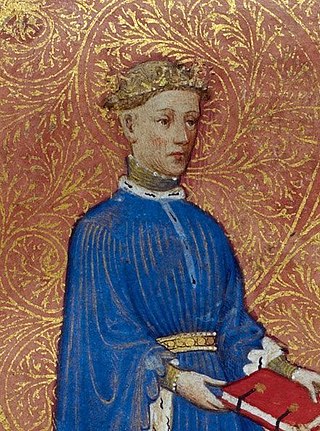
Henry V, also called Henry of Monmouth, was King of England from 1413 until his death in 1422. Despite his relatively short reign, Henry's outstanding military successes in the Hundred Years' War against France made England one of the strongest military powers in Europe. Immortalised in Shakespeare's "Henriad" plays, Henry is known and celebrated as one of the greatest warrior-kings of medieval England.

Edward IV was King of England from 4 March 1461 to 3 October 1470, then again from 11 April 1471 until his death in 1483. He was a central figure in the Wars of the Roses, a series of civil wars in England fought between the Yorkist and Lancastrian factions between 1455 and 1487.

Henry VI was King of England from 1422 to 1461 and again from 1470 to 1471, and disputed King of France from 1422 to 1453. The only child of Henry V, he succeeded to the English throne at the age of nine months upon his father's death, and succeeded to the French throne on the death of his maternal grandfather, Charles VI, shortly afterwards.
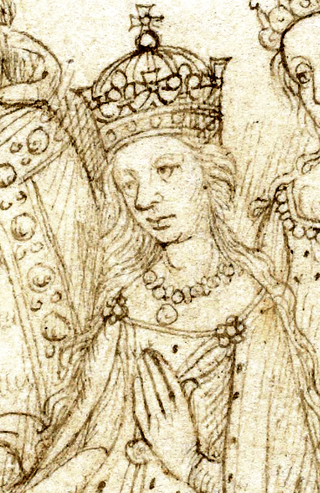
Catherine of Valois or Catherine of France was Queen of England from 1420 until 1422. A daughter of Charles VI of France, she was married to Henry V of England and gave birth to his heir Henry VI of England. Catherine's marriage was part of a plan to eventually place Henry V on the throne of France, and perhaps end what is now known as the Hundred Years' War, but although her son Henry VI was later crowned in Paris, this ultimately failed.

Margaret of Anjou was Queen of England and nominally Queen of France by marriage to King Henry VI from 1445 to 1461 and again from 1470 to 1471. Born in the Duchy of Lorraine into the House of Valois-Anjou, Margaret was the second eldest daughter of René, King of Naples, and Isabella, Duchess of Lorraine.
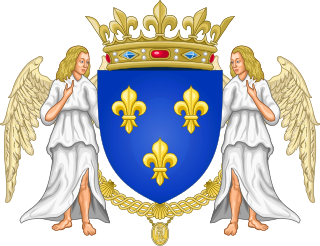
The Capetian house of Valois was a cadet branch of the Capetian dynasty. They succeeded the House of Capet to the French throne, and were the royal house of France from 1328 to 1589. Junior members of the family founded cadet branches in Orléans, Anjou, Burgundy, and Alençon.

Charles VI, nicknamed the Beloved and later the Mad, was King of France from 1380 until his death in 1422. He is known for his mental illness and psychotic episodes that plagued him throughout his life.

Richard of York, 3rd Duke of York, also named Richard Plantagenet, was a leading English magnate and claimant to the throne during the Wars of the Roses. He was a member of the ruling House of Plantagenet by virtue of being a direct male-line descendant of Edmund of Langley, King Edward III's fourth surviving son. However, it was through his mother, Anne Mortimer, a descendant of Edward III's second surviving son, Lionel of Antwerp, that Richard inherited his strongest claim to the throne, as the opposing House of Lancaster was descended from John of Gaunt, Duke of Lancaster, the third surviving son of Edward III. He also inherited vast estates and served in various offices of state in Ireland, France and England, a country he ultimately governed as Lord Protector during the madness of King Henry VI.

The House of Lancaster was a cadet branch of the royal House of Plantagenet. The first house was created when King Henry III of England created the Earldom of Lancaster—from which the house was named—for his second son Edmund Crouchback in 1267. Edmund had already been created Earl of Leicester in 1265 and was granted the lands and privileges of Simon de Montfort, 6th Earl of Leicester, after de Montfort's death and attainder at the end of the Second Barons' War. When Edmund's son Thomas, 2nd Earl of Lancaster, inherited his father-in-law's estates and title of Earl of Lincoln he became at a stroke the most powerful nobleman in England, with lands throughout the kingdom and the ability to raise vast private armies to wield power at national and local levels. This brought him—and Henry, his younger brother—into conflict with their cousin King Edward II, leading to Thomas's execution. Henry inherited Thomas's titles and he and his son, who was also called Henry, gave loyal service to Edward's son King Edward III.
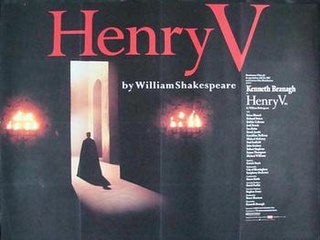
Henry V is a 1989 British historical drama film adapted for the screen and directed by Kenneth Branagh, based on William Shakespeare's play of the same name about King Henry V of England. The film stars Branagh in the title role with Paul Scofield, Derek Jacobi, Ian Holm, Emma Thompson, Alec McCowen, Judi Dench, Robbie Coltrane, Brian Blessed, and Christian Bale in supporting roles.

Henry VI, Part 1, often referred to as 1 Henry VI, is a history play by William Shakespeare—possibly in collaboration with Thomas Kyd and Thomas Nashe or Christopher Marlowe — believed to have been written in 1591. It is set during the lifetime of King Henry VI of England.

Edward of Westminster, also known as Edward of Lancaster, was the only son of Henry VI of England and Margaret of Anjou. He was killed aged seventeen at the Battle of Tewkesbury.
The Treaty of Troyes was an agreement that King Henry V of England and his heirs would inherit the French throne upon the death of King Charles VI of France. It was formally signed in the French city of Troyes on 21 May 1420 in the aftermath of Henry's successful military campaign in France. It forms a part of the backdrop of the latter phase of the Hundred Years' War finally won by the French at the Battle of Castillon in 1453, and in which various English kings tried to establish their claims to the French throne.

From the 1340s to the 19th century, excluding two brief intervals in the 1360s and the 1420s, the kings and queens of England and Ireland also claimed the throne of France. The claim dates from Edward III, who claimed the French throne in 1340 as the sororal nephew of the last direct Capetian, Charles IV. Edward and his heirs fought the Hundred Years' War to enforce this claim, and were briefly successful in the 1420s under Henry V and Henry VI, but the House of Valois, a cadet branch of the Capetian dynasty, was ultimately victorious and retained control of France, except for Calais and the Channel Islands. English and British monarchs continued to prominently call themselves kings of France, and the French fleur-de-lis was included in the royal arms. This continued until 1801, by which time France no longer had any monarch, having become a republic. The Jacobite claimants, however, did not explicitly relinquish the claim.

The Lancastrian War was the third and final phase of the Anglo-French Hundred Years' War. It lasted from 1415, when King Henry V of England invaded Normandy, to 1453, when the English lost Bordeaux. It followed a long period of peace from the end of the Caroline War in 1389. The phase is named after the House of Lancaster, the ruling house of the Kingdom of England, to which Henry V belonged.
Events from the 1420s in England.
Events from the 1450s in England.

The Hundred Years' War was a series of armed conflicts between the kingdoms of England and France during the Late Middle Ages. It originated from disputed claims to the French throne between the English House of Plantagenet and the French royal House of Valois. Over time, the war grew into a broader power struggle involving factions from across Western Europe, fuelled by emerging nationalism on both sides.
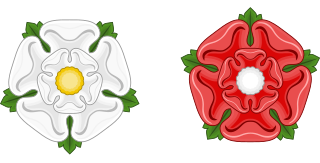
The First Battle of St Albans was fought on 22 May 1455 at St Albans, 22 miles (35 km) north of London, and traditionally marks the beginning of the Wars of the Roses in England. Richard, Duke of York, and his allies, the Neville earls of Salisbury and Warwick, defeated a royal army commanded by Edmund Beaufort, Duke of Somerset, who was killed. With King Henry VI captured, a subsequent parliament appointed Richard of York Lord Protector.